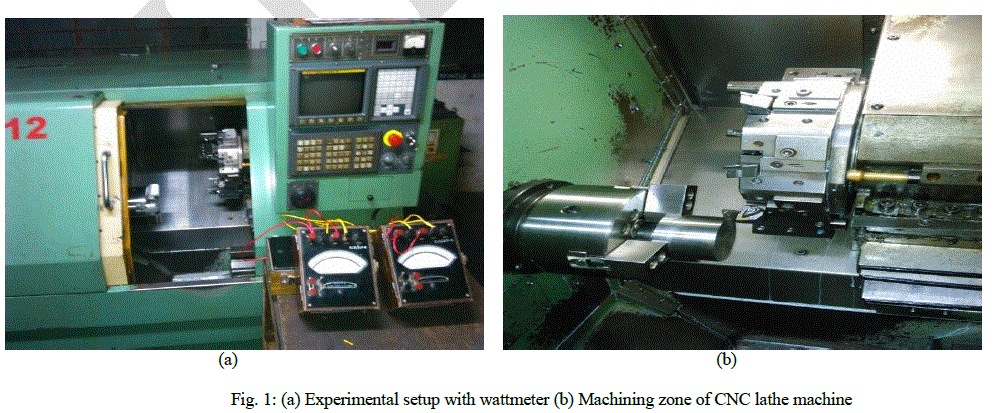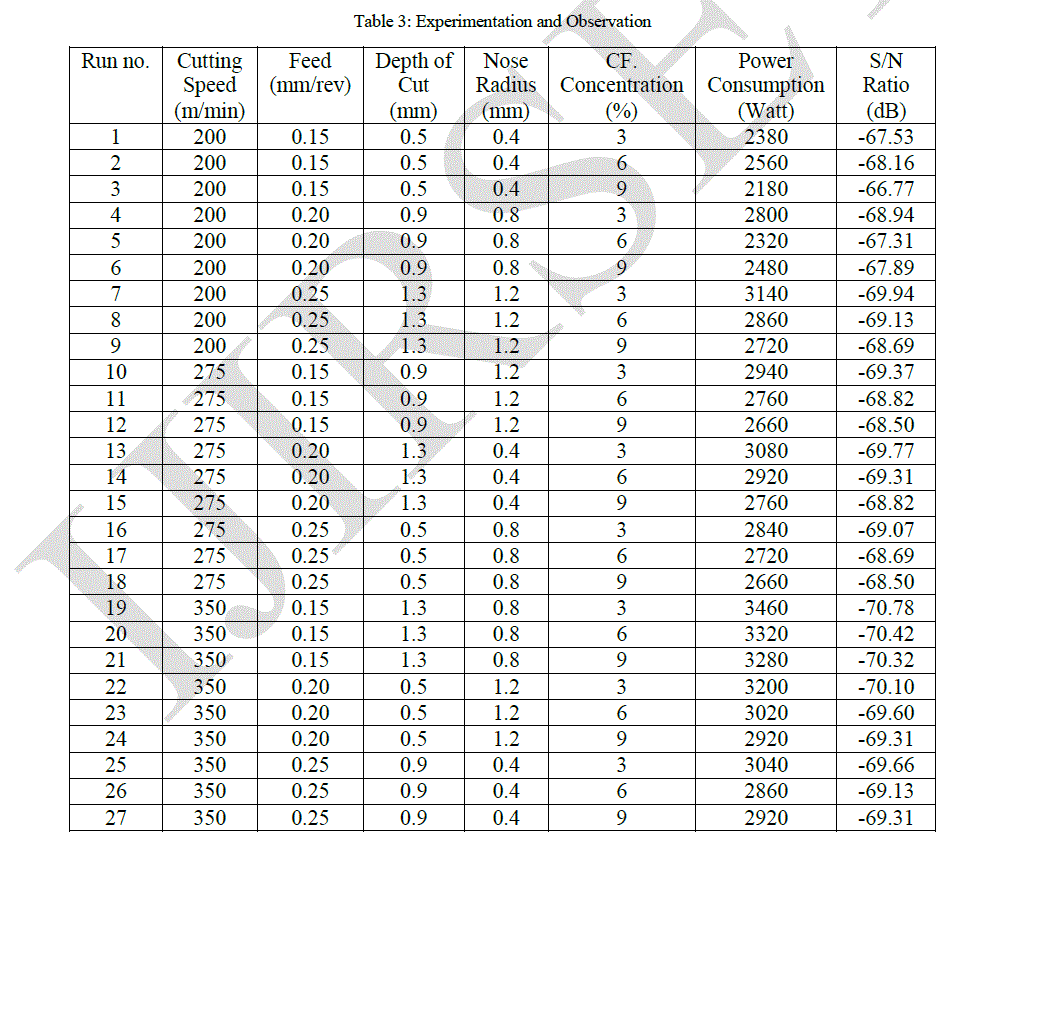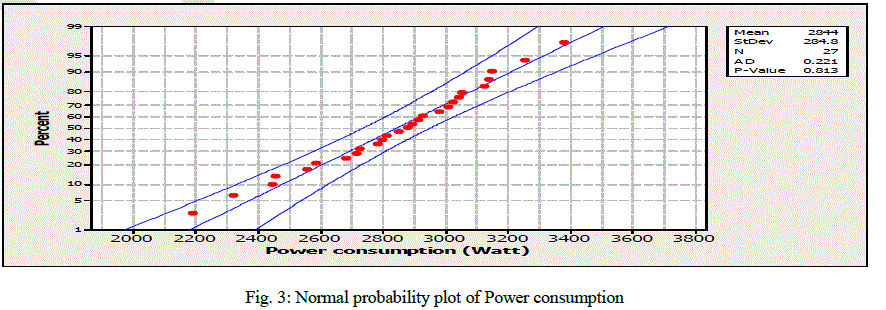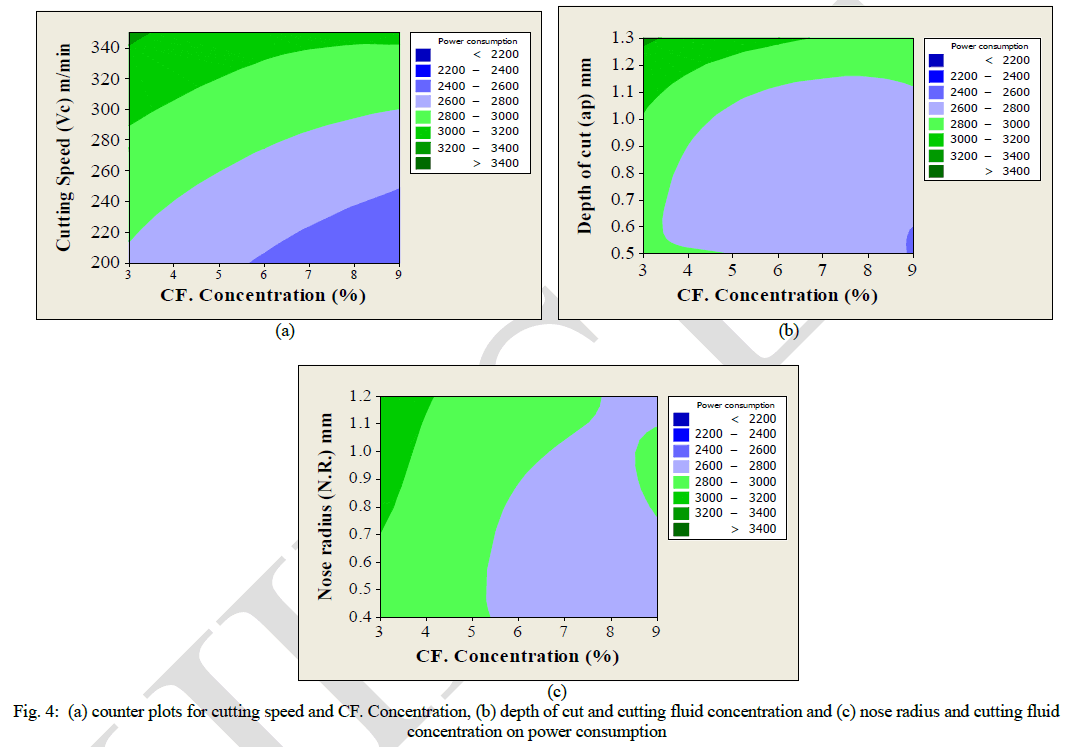ISSN ONLINE(2319-8753)PRINT(2347-6710)
ISSN ONLINE(2319-8753)PRINT(2347-6710)
Aditya Kulkarni1, Hemant Mandave2, Vajay Sabnis3
|
| Related article at Pubmed, Scholar Google |
Visit for more related articles at International Journal of Innovative Research in Science, Engineering and Technology
This study investigated the parameter optimization of CNC turning operation for AISI 1040 steel based on Taguchi approach. AISI 1040 steel has wide application in manufacturing sector. Cutting speed (m/min), feed (mm/rev), depth of cut (mm), nose radius (mm) and cutting fluid concentration (%) are optimized for power consumption as performance characteristic. L27 Orthogonal Array was used and analysis of variance (ANOVA) is also applied to identify most significant factor. Optimal parametric combination 200m/min-0.15mm/rev-0.5mm-0.4-9%was obtained and validated. It has been observe that cutting speed has most significant factor followed by depth of cut and cutting fluid concentration on Power consumption. Power consumption decreases with decrease in cutting speed (350 to 200 m/min) and depth of cut (1.3 to 0.5mm) while increase in cutting fluid concentration (3 to 9%).
Keywords |
| Power consumption, cutting fluid concentration, ANOVA |
I. INTRODUCTION |
| Turning is one of the most common methods for cutting and especially for the finishing of components. The goal of the modern industries is to manufacture low cost, high quality products in short time. In turning, to achieve high cutting performance, selection of optimum parameters is very essential[1].It has long been recognized that cutting conditions such as feed rate, cutting speed and depth of cut in machining operation should be selected to optimize the economics of machining operations as assessed by productivity, total manufacturing cost per component or some other suitable criteria. Because of the high cost of numerically controlled machine tools compared to their conventional counterparts, there is an economic need to operate these machines as efficiently as possible in order to obtain the required payback [2].In machining processes, saving money and improving sustainability performance can be achieved by reducing power consumption because power is an essential resource for production. The strategies to reduce power consumption are obtaining emphasis due to the constant increase in electricity prices, and concern of manufacturing companies and clients about the environmental impact that results from activities related to the production of goods. Computerized Numerical Control (CNC) machine tools, including those that perform turning operations, contribute significantly to the power consumption in the manufacturing sector [3]. Of the many goals focused in a manufacturing industry, power consumption plays a vital and dual role. One, it cuts down the cost per product and secondly the environmental impact by reducing the amount of carbon emissions that are created in using the electrical energy [4]. In order to minimize such machining problems, scientific methods based on Taguchi design of experiments were used. The experimentation for this work was based on TaguchiâÃâ¬ÃŸs design of experiments (DOE) and orthogonal array. A large number of experiments have to be carried out when the number of the process parameters increases. To solve this task, the Taguchi method uses a special design of orthogonal arrays to study the entire parameter space with a small number of experiments only [5]. |
II. LITERATURE SURVEY |
| M. Adinarayana, et al. [6] studied optimization of power consumption in turning operations using CVD cutting tool on AISI 4340 Alloy Steel with speed, feed and depth of cut as a control parameters. Result obtained was, power consumption is increase with increase in cutting speed, feed rate and depth of cut. R. Suresh, et al.[7] studied that performance of multilayer hard coatings (TiC/TiCN/Al2O3) on cemented carbide substrate using chemical vapor deposition (CVD) for machining of hardened AISI 4340 steel using Taguchi approach in turning process by cutting speed, feed and depth of cut as a controlled factor and power consumption as performance measure. Result found was cutting speed has the highest influence on the machining power required to perform machining operation (77.67%) followed by feed rate (17.39%) and depth of cut (2.82%). D. Babu, et al. [4] studied optimization of power consumption using TaguchiâÃâ¬ÃŸs technique. Experiment was conducted with an extruded aluminium shaft on a CNC lathe with cutting speed, feed rate and depth of cut as process parameters. It was observed that the feed rate and the depth of cut are greatly influencing the power consumption. A. Agggarwal, et al. [2] studied effect of cutting speed, feed rate, depth of cut, nose radius and cutting environment in CNC turning of AISI P-20 tool steel by using response surface methodology (RSM) and TaguchiâÃâ¬ÃŸs technique for power consumption. Result found was, cryogenic environment is the most significant factor in minimizing power consumption followed by cutting speed and depth of cut. H. Singh, et al. [8] investigated the effects of cutting parameters like spindle speed, feed and depth of cut on surface finish and material removal rate of EN-8 on CNC Lathe by using CNMG120408 insert with Taguchi approach. The results found was, spindle speed contributed 63.90%, depth of cut contributed 11.32% and feed rate contribution was 8.33% for Ra. D. Singh, et al, [9] investigated the effects of cutting parameters like spindle speed, feed and depth of cut on surface finish and material removal rate on EN-8 under turning conditions on CNC lathe by using carbide tool. Response Surface Methodology (RSM) has applied to optimize cutting parameters. Result found was that speed and depth of cut are put negligible effect on the surface roughness and feed rate shown increasing trend. K. Kumar, et al. [10] investigated influence of cutting conditions in facing operation (surface finish) of EN-8 using cemented carbide insert. Experiment conducted by using three levels of cutting speed (100, 360, 560) rpm, three levels of feed (0.14, 0.15, 0.16) mm/rev and three levels of depth of cut (0.5, 1, 1.5) mm with L27 Orthogonal array. Result was found that the effect of feed rate is more considerable than cutting speed on surface roughness. |
| The literature reveals that, power consumption is one of the important issues in manufacturing industry and limited literature is available on this. Further, experimentation carried out for optimization of power consumption considering cutting parameters and tool geometry only but influence of cutting fluid (CF) concentration over power consumption is not analyzed. As cutting fluid overcome resistance in machining process, so there is possibility that CF. concentration plays vital role in minimizing power consumption. Hence in present study optimization was conducted on CNC turning of AISI 1040 steel using Taguchi approach with cutting speed (m/min), feed (mm/rev), depth of cut (mm), nose radius (mm) and CF. concentration (%) as a controlled parameter. |
III. WORKPIECE MATERIAL |
| The work material selected for the study was AISI 1040 medium carbon steel which is used extensively for the manufacture of parts such as general-purpose axles and shafts, gears, bolts and studs. It finds wide varieties of application for forging, casting, crank shaft and connecting rods along with low cost die material in tool and die making industries [11]. The chemical composition of AISI 1040 steel was evaluated using an optical emission spectrometer and the obtained chemical composition is given in Table 1.Work piece material in the form of circular cross section having 80mm diameter and 60 mm length cut from a single parent round bar. |
 |
IV. CUTTING TOOL |
| Mitsubishi make Chemical vapour deposit (CVD) coated carbide inserts having tool geometry CNMG 120404, CNMG 120408; CNMG 120412 was used with PCLNR 2525 tool holder. The CVD coating consist of “2 in 1 technology” of “Nano-texture coating” and “Black super smooth coating” which achieve high wear resistance, high fracture resistance and high stability. |
V. PLANNING OF EXPERIMENT |
| The experimentation for this study was based on TaguchiâÃâ¬ÃŸs design of experiments (DOE) and orthogonal array. Based on the literature reviewed, in present investigation three levels are defined for each of the identified factor as shown in Table 2. In current study five process parameters with each of three levels was selected for CNC turning of AISI 1040 steel. For a five factors, three level experiments, Taguchi had specified L27 orthogonal array and is shown in Table 3. |
 |
VI. EXPERIMENTAL SETUP |
| The experimental work was carried out at Abhijat Equipment Pvt. Ltd. Satara on Computerized Numerical Control (CNC) lathe machine shown in figure 1(a) and 1(b). Canned cycle was used for machining and the machining was done in absolute mode. Water soluble cutting fluid of Atlantic lubrication was used for experimental work. 3%, 6% and 9% concentrations cutting fluid (CF) are made separately for 50 litter water. Power consumption was measured by using two wattmeter method. Both calibrated wattmeter was used and their reading were added after multiplying suitable multiplying factor to get Power Consumption (PC) in watt. The response obtained from the trials conducted as per L27orthogonal array was recorded in Table 3. |
 |
VII. S/N ANALYSIS |
| The term „„signalâÃâ¬ÃŸÃ¢Ãâ¬ÃŸ represents the desirable effect for the output characteristic and the term „„noiseâÃâ¬ÃŸÃ¢Ãâ¬ÃŸ stands for the undesirable effect for the output characteristic. S/N ratio measures the quality characteristics deviating from the desired value and higher S/N ratio means the optimal level of the process parameters. For “Smaller-the Better” quality characteristic, S/N ratio calculated by equation 1, |
 |
 |
| In current experimental work output performance is power consumption, consider as “Smaller-the –Better” quality characteristic. So S/N ratio values calculated by taking equation (1) into consideration were given in Table 3. |
VIII. OPTIMUM PARAMERIC COMBINATION |
| The S/N ratio main effect plot of Power consumption with respect to cutting speed, feed, Depth of cut, Nose radius and Cutting fluid concentration is shown in figure 2. This figure shows, power consumption significantly goes on increasing with increasing cutting speed from 200m/min to 350m/min along with 0.5mm to 1.3mm depth of cut. Increase in feed rate and nose radius shows moderate increase in power consumption however, cutting fluid concentration shows reverse influence on power consumption compare with other input process parameter. Power consumption goes on decreasing with increasing cutting fluid concentration from 3% to 9%. |
 |
| Table 3 shows S/N ratios of power consumption for each experimental run of L27 orthogonal array. Table 4 shows Response table for S/N ratio. The level of parameter with the highest S/N ration gives the optimal level. All the optimal machining parameters level is marked with * in Table 4 and on basis of these levels of S/N ratio, rank of the input parameter is estimated. |
 |
| Optimal levels are indicated by * |
| From S/N ratio plots (figure 2) and response table for S/N rations of power consumption (Table 4), the optimal parametric setting for achieving best results during CNC turning operation for minimum power consumption have been found and summarized in Table 5. |
 |
IX. ANALYSIS OF VARIANCE |
| Analysis of variance is used to identify the statistical significance of individual parameter on a particular response. In current study ANOVA was utilized to determine the statistical significant factors influencing the power consumption during CNC turning of AISI 1040 steel and to determine the percentage contribution of each control factor on response. ANOVA results were given in Table 6. The analyses were made for the level of confidence 95% (the level significance is 5%). Cutting speed, depth of cut and cutting fluid concentration influenced the Power consumption by 48.14%, 24.99% and 12.13% respectively. From the analysis of this table, it could be observed that cutting speed, depth of cut, Nose radius and cutting fluid concentration had statistical and physical significance on the Power consumption because P value was lower than 0.05. |
 |
X. MATHAMATICAL MODELLING |
| The relationship between independent and dependent variables is determined by regression analysis. Regression analysis is used to predict dependent variables as a function of independent variables. Regression equitation model (eq.3) were developed by using Minitab 16.1 software to find out correlation between input parameters as Cutting speed (Vc) m/min , Feed (f) mm/rev, Depth of cut (ap) mm , Insert Nose radius (N.R.) mm and CF. Concentration % for obtaining Power Consumption. |
| Power consumption = 1567 + 3.39 Cutting Speed (Vc) m/min + 244 Feed (f) mm/rev + 425 Depth of cut (ap) mm + 211 Nose radius (N.R.) mm - 42.6 CF. Concentration |
| By using Minitab 16 software Normal probability plot of residuals verses the predicted response for power consumption was plotted in figure 3. It shows that data closely follow straight line. The null hypothesis is that the data native hypothesis is that it is non- normal distribution law is normal and alter so it implies the models proposed are adequate. Using the p value which is greater than alpha of 0.05(level of significance), the null hypothesis cannot be rejected (that is, the data follow a normal distribution). It implies that the proposed model is adequate. |
 |
XI. COUNTER PLOTS |
| Figure 4(a), (b) and (c) are the Counter plots drown by using Minitab 16 statistical software for power consumption considering cutting speed versus cutting fluid concentration, depth of cut versus cutting fluid concentration and nose radius versus cutting fluid concentration respectively. Analysis of these counter plots shows that, increasing cutting parameter as cutting speed and depth of cut power consumption also increases while increasing cutting fluid concentration significantly decrease in power consumption occur. |
 |
XII. VALIDATION |
| Validation experiment was carried out on optimum parametric combination as per Table 5 to check validity of optimized result of response criteria. Table 7 shows the predicted S/N ratio values based on Taguchi and experimental S/N ratio values at optimum parametric combination for the power consumption. |
 |
| From Table 7, the percentage error of predication in S/N ratio for power consumption at optimum parametric combination is 0.58%. This error percentage is tolerated, so it is confirmed that the optimization of CNC process parameters has been successfully achieved. |
XIII. CONCLUSION |
| Taguchi approach is used in this study to optimize CNC turning of AISI 1040 steel for power consumption by considering input parameter as cutting speed, feed, depth of cut, nose radius and cutting fluid concentration. The following conclusions can be deduced from the findings of this study: |
| Based on Taguchi analysis, the optimal parametric combinations of the process parameters for minimizing power consumption is obtained as 200m/min-0.15mm/rev-0.5mm-0.4mm-9%. |
| ANOVA result shows that cutting speed (48.15%), depth of cut (24.99%) and cutting fluid concentration (12.13%) has physical as well as statistical influence on power consumption. |
| Validation experimentation has been performed on optimal settings and the error in experimental S/N ratio of turning depth deviation at the optimal parametric combinations with respect to predicted results obtained is satisfactory. |
| Increase in cutting fluid concentration level from 3% to 9% resulted significantly decrease in power consumption. |
References |
|